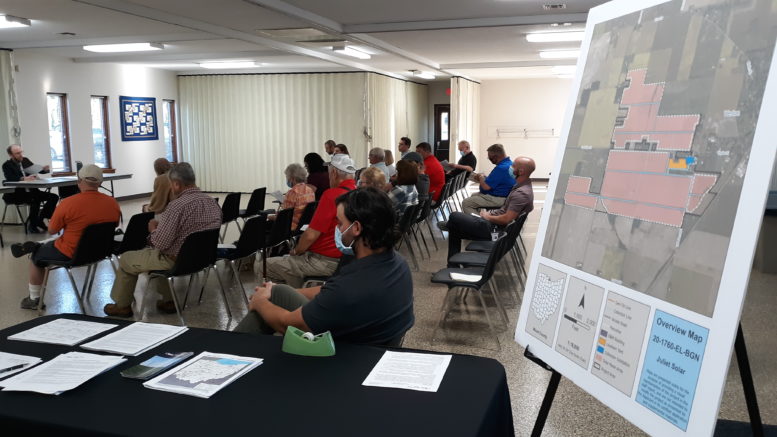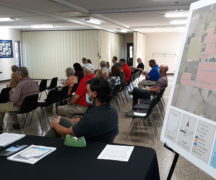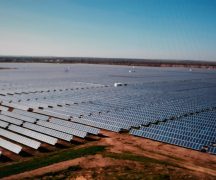By JAN LARSON McLAUGHLIN
BG Independent News
Neighbors of the proposed 670-acre solar field near Weston got to weigh in on the project Wednesday evening during a public hearing.
The Ohio Power Siting Board listened as people testified about the economic and energy benefits of the solar field, the loss of prime farmland, and the harm it will cause the homes swallowed up by the site.
Juliet Energy Project LLC plans to construct an up to 101-megawatt solar farm in Weston and Milton townships and the village of Weston. The proposed solar farm is five times the size of Bowling Green’s solar field northeast of the city.
The Juliet Solar project would consist of large arrays of solar panels on 670 acres of private land, on the west side of the village of Weston. The project would include associated facilities such as access roads, electric collection lines, inverters, weather stations, a substation and an operations and maintenance facility.
A total 30 residential properties will be affected by the proposed Juliet Solar Farm, which touches homes on Sand Ridge, Weston and Milton roads. Some residential properties along Sand Ridge Road will be surrounded by solar panels on all four sides since the proposed solar farm stretches on both sides of the road.
Speaking in favor of the solar project were representatives of Local 18 Operating Engineers, and the Toledo Chamber of Commerce. Brian Dicken, of the chamber, said the solar field will contribute to the energy resilience of the region, create about 200 construction jobs, and bring in $800,000 annually in tax revenue for schools, the townships and village.
Weston Mayor Jeremy Schroeder talked about the village benefitting from the solar field tax revenue.
“There are only a handful of opportunities for growth” in a small village, without taxing residents, Schroeder said.
“Development spurs growth, and I’m in favor of that,” he said.
The solar field would mean a loss of corn and soybean fields, but “it will be used to farm sunlight,” Schroeder said.

But some neighbors voiced strong objections to the solar project.
Alina Hass, of Weston Road, questioned the accuracy of the promises made by the solar firm.
“Solar projects present an intoxicating opportunity,” she said. But they “have a very long history of failure.”
Haas talked about the unexpected consequences of the solar project, the lack of sunshine in Ohio, and the highly subsidized nature of solar energy.
“So when they fail, they also fail the taxpayers,” she said.
“We don’t have the benefit of falling back on the promises that were made,” Haas added.
Her husband, Bradley Haas, said the solar project “comes up to our backdoor.”
As a farmer, Haas said the loss of prime farmland is troubling.
“I’m not too excited about land being covered up with solar panels,” he said.
“This is going to be covering up some of the best ground in Weston Township,” Bradley Haas said, comparing it to replacing nice suburban homes with low income apartments.
Steve Espen, also of Weston Road, voiced his displeasure with the project.
“I don’t know how we’re going to trust BP,” he said of British Petroleum which purchased the company planning the solar field. “This project was rolled out in secret.”
Espen said the company has stated there is no evidence that property values near the solar field will decline. But he found one study showing residential landowners will lose money for their properties.
“I know we’re probably going to get stuck with it,” Espen said. “At least I got to say something.”
Another neighbor on Weston Road, Bob Desmond, expressed mixed feelings about the project.
“I am for the economic development of the project,” Desmond said. But he is unhappy about a solar field substation being planned next to his home. “It’s unfortunate it’s going to be in our backyard.”
Paul Chamberlin, whose family has farmed for generations, said he was initially opposed to the solar project.
“I said, ‘No way,’” when approached about leasing land for the project.
But after talking with family members, Chamberlain decided to lease some acreage to the solar farm.
“Rural life is changing,” he said. “I might be old, but I support this project fully.”
Those residents saddened about losing their rural settings got some support from Norm Heineman, a resident of rural Center Township.
“I feel sorry for the people who live in the area,” Heineman said. Though not opposed to solar energy, he doesn’t like the idea of homes being surrounded on three or four sides by solar panels.
“We all make decisions of where to live,” he said. “We seem to like the wide open spaces, the uninterrupted vistas. There’s something about living in a township that appeals to certain people.”
Heineman also said he questioned “taking good productive soil out of production.”
The Ohio Power Siting Board staff conducted an investigation of the Juliet Energy Solar project application and prepared a report making recommendations to the OPSB members. The staff recommended that construction of the solar farm be subject to 30 conditions, including requiring Juliet Energy Solar to:
- Prepare a landscape and lighting plan addressing aesthetic and lighting impacts where an adjacent non-participating parcel contains a residence with a direct line of sight to the facility.
- General construction activities shall be limited to the hours of 7 a.m. to 7 p.m., or dusk when sunset occurs after 7 p.m.
- Have an environmental specialist on site during construction activities that may affect sensitive areas such as wetland and streams, and potential threatened or endangered species.
- Implement a complaint resolution process to address potential complaints resulting from facility construction and operation, and provide a total decommissioning plan and cost estimate.
- Install a perimeter fence type that is both wildlife permeable and aesthetically fitting for a rural location and prevent the establishment of noxious weeds, and if found to be present, remove and treat them with herbicides as necessary.
- Avoid or minimize damage to functioning field tile drainage systems and agricultural soils and promptly repair damaged field tile systems to at least original conditions or modern equivalent.
- Submit an updated decommissioning plan and total decommissioning cost estimate without regard to salvage value.
The next step in the Ohio Power Siting Board process is an evidentiary hearing on Sept. 22, at 10 a.m., in the offices of the PUCO, Columbus.



